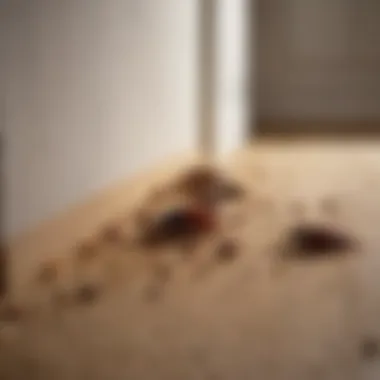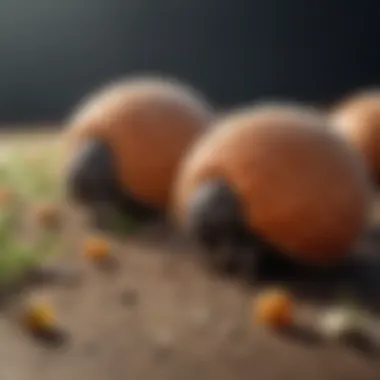Evaluating Mothballs for Effective Roach Control


Overview of the Topic
Definition and Importance
Mothballs are small, typically round balls made from chemical compounds that release a strong odour. They have long been utilized to protect clothing and other materials from moth damage. However, their efficacy extends beyond their original purpose. Recent discussions have emerged surrounding the potential of mothballs in controlling roach populations. Understanding how they work is vital, especially for farmers and enthusiasts concerned about pest management.
This examination not only focuses on their functionality but also assesses the safety and practicality of using mothballs compared to other pest control methods. The aim is to provide relevant insights into whether these products can serve as viable solutions for roach infestations.
Current Trends
As urbanisation increases, so do pest challenges. Many individuals and professionals explore natural and chemical pest control alternatives. The rise in demand for safer pest management solutions has prompted a reevaluation of traditional methods. Mothballs, often overlooked, are experiencing renewed interest as an accessible and potentially effective option for roach control. -
Recent studies indicate that the chemical components in mothballs may deter roaches, making it essential to explore this further. As homeowners seek simpler and more effective methods, understanding how to harness mothballs against roaches can contribute to modern pest management strategies.
Key Techniques and Practices
Step-by-Step Guide
- Identify the Infestation: First, determine the extent of the roach infestation. Look for droppings, egg cases, or sightings in various areas.
- Choose the Right Mothballs: Opt for mothballs specifically designed for pest control, as not all versions have the same effectiveness.
- Placement: Place mothballs in strategically chosen areas such as cabinets, under sinks, and along baseboards. Keep them away from children and pets.
- Duration: Allow the mothballs to remain undisturbed for an appropriate duration to let their chemical vapours disperse adequately. Monitoring the area during this time is essential.
- Evaluate Efficacy: After a set period, observe reduction in roach sightings or activity. If needed, consider adding more mothballs or combining methods for better results.
Tools and Equipment Needed
- Protective gloves: Essential to protect your hands while handling mothballs.
- Containers: Designate closed containers for mothballs in areas to prevent unintentional contact.
- Tape measure: Useful for determining the spacing of mothballs in larger areas.
- Trash bags: For disposing of any dead roaches or waste to maintain hygiene.
Challenges and Solutions
Common Obstacles
Utilizing mothballs for roach control can pose several challenges. For instance, the strong odour may deter homeowners from employing them, it can raise safety concerns around pets and children. Additionally, not all types of roaches respond to mothballs in the same manner.
Innovative Solutions
To mitigate these obstacles, homeowners should continuously follow safety guidelines. Using mothballs in closed spaces can help contain the odour to a manageable level. Combining pest control methods, such as cleanliness and exclusion measures, can also lead to a more holistic approach.
According to many studies, the effectiveness of mothballs in pest control revolves not just around their chemical properties but also how they are integrated into an overall pest management plan.
When we weigh the risks and benefits, mothballs remain a potent option. However, being informed and methodical in their application is crucial to achieving satisfactory outcomes.
Prolusion to Roach Infestations
Roach infestations pose significant concerns for homeowners and professionals alike. Understanding these infestations is crucial in managing and preventing their impact on living spaces. Roaches are not only unpleasant to encounter, but they also carry health risks through contamination of food and surfaces. Recognizing the behaviors and habits of cockroaches can influence control strategies effectively. Additionally, this knowledge aids in understanding the persistence of such infestations.
Understanding Cockroach Behavior
Cockroaches exhibit distinct behaviors that make them successful at surviving in various environments. They are nocturnal creatures, preferring to avoid light. This behavior makes them more active at night, searching for food and water. Roaches are drawn to warmth and moisture, meaning kitchens and bathrooms often become their primary habitats. Learning about their inclination towards certain habitats can guide targeted strategies for elimination and prevention.
From a reproductive perspective, cockroaches reproduce rapidly. Female roaches produce numerous eggs in cases, which can hatch quickly, leading to swarming populations. After finding evidence of cockroaches, immediate action becomes necessary to prevent escalation. Homeowners should pay attention to signs of infestation, such as droppings, egg cases, and shed skins, as these indicators reveal the need for prompt management measures.
The Impact of Roach Infestations


Roach infestations can severely affect health and hygiene. Cockroaches are known carriers of various pathogens, which can lead to food poisoning and other illnesses. Their droppings, saliva, and shed skins can trigger allergic reactions and respiratory issues, particularly in sensitive individuals. This is especially problematic in households with children, the elderly, or those with pre-existing health conditions.
Furthermore, infestations can lead to costly damage to property. Cockroaches may chew through materials such as paper, fabric, or even wiring, leading to structural and financial damage. Understanding these impacts underscores the urgency of addressing roach problems, making it vital to explore effective control methods, including the use of mothballs.
Chemical Composition of Mothballs
The analysis of mothballs is crucial in understanding their role as a potential method for controlling roach populations. Mothballs are primarily designed for protecting clothing and textiles from moths, but their chemical properties might lend them some effectiveness against different types of pests, including cockroaches. Knowing the composition reveals much about their efficacy in pest control and the implications of their use in a domestic or agricultural setting.
Common Ingredients in Mothballs
Mothballs typically contain active ingredients such as naphthalene or paradichlorobenzene. Both compounds have distinct chemical structures and properties that influence their behavior in pest management. Here are some key details:
- Naphthalene: This is a white, crystalline solid that is volatile at room temperature. Its sharp odor is easily recognizable and is a deterrent for many insects. In higher concentrations, naphthalene can disrupt insect normal functioning and potentially lead to their demise.
- Paradichlorobenzene: A more potent chemical, it presents a higher vapor pressure. It is often used in mothballs due to its effectiveness against a variety of pests. It can also lead to similar deterrent and lethal effects as naphthalene, but comes with different safety considerations.
Understanding the ingredients helps to determine how these substances interact with cockroaches. Some studies point out their potential for impacting the respiratory systems of insects, making them less capable of surviving in treated areas.
Mechanism of Action Against Insects
The mechanism of action for mothballs against cockroaches is quite straightforward. These chemicals, when placed in a confined area, release vapors that saturate the surrounding environment. These vapors are toxic to insects, particularly respiratory organisms like roaches. As they inhale the vapors, their metabolic processes can be disrupted, leading to eventual death or effective deterrence from the area.
In addition to the respiratory impacts, certain chemicals might interfere with the endocrine system of cockroaches. This disruption can affect reproduction, making it challenging for populations to sustain themselves.
Key Takeaway: Mothballs can provide a temporary method to reduce cockroach populations due to the toxic properties of naphthalene and paradichlorobenzene. However, the effects are contingent on proper placement and concentration within the environment, making careful consideration important in any pest control strategy.
Are Mothballs Effective Against Roaches?
The topic of mothballs as a potential solution for combating roach infestations is significant in pest control discussions. Mothballs are often employed for their intended purpose of repelling moths, but their efficacy towards cockroaches presents a different narrative that warrants thorough examination. Understanding the effectiveness of mothballs against roaches can help homeowners and pest control professionals make informed decisions about pest management strategies.
One of the primary considerations is the active ingredients found in mothballs. Understanding how these components interact with roach biology can shed light on their potential impact. Additionally, evaluating studies that explore their effectiveness can validate or challenge claims associated with their use. With robust evidence, stakeholders can evaluate whether mothballs are a feasible method for controlling roach populations in various environments.
With these factors in mind, a deeper exploration into specific studies and documented case applications will illustrate the practical effectiveness of mothballs in roach control. The results can determine not just the practicality, but also the ideal circumstances where these products might offer tangible benefits.
Scientific Studies and Evidence
The number of scientific studies directly addressing the effectiveness of mothballs on cockroaches is somewhat limited. However, those that do exist often focus on the key active ingredient, typically naphthalene or paradichlorobenzene, both of which have insect-repelling properties. Research conducted on the behavior of roaches in environments treated with these substances indicates a limited effectiveness.
For instance, experiments show that while roaches may avoid areas where mothballs are present, this does not necessarily lead to a long-term reduction in their population levels. Additionally, some findings suggest that the effectiveness may vary significantly based on the concentration of mothballs used and the duration of exposure. The following points summarize findings from scientific investigations:
- Roach Avoidance: Cockroaches display a tendency to avoid areas that emit strong vapors associated with mothballs.
- Limited Population Control: Usage of mothballs alone may not lead to a significant decrease in roach populations over time.
- Behavioral Changes: Exposure to mothballs may alter cockroach behavior but does not address the underlying infestation problem.
Case Studies in Pest Control
Several case studies across urban and rural settings illustrate the varied experiences of pest control professionals regarding the use of mothballs against roach populations. In many instances, homeowners report a temporary reduction in sightings shortly after application; however, roaches oftentimes return once the effects of the mothballs dissipate.
For example, one homeowner battled a severe roach infestation in an apartment complex. After placing mothballs in strategic locations, they observed fewer roaches for about two weeks. This initial success led them to believe that mothballs were an effective solution. However, within a month, the roach population rebounded.
On the other hand, a pest control specialist noted using mothballs in combination with other methods, like bait traps and improved sanitation measures, yielded better long-term results. This suggests that while mothballs may have some repellent qualities, they are more effective as a supplementary method rather than a standalone solution.
"To achieve a lasting impact on roach populations, it is essential to integrate multiple control strategies rather than rely solely on mothballs."


The anecdotal evidence aligns with scientific findings that stress the importance of comprehensive pest management. For those interested in more information regarding alternative pest control measures, resources such as Wikipedia or Britannica can provide valuable insights.
Risks and Safety Considerations
When discussing the use of mothballs as a method for controlling roach populations, it is vital to consider the associated risks and safety protocols. Mothballs may seem like an effective solution against roaches, but their chemical nature poses significant health and environmental considerations. Understanding these risks will help homeowners and pest control professionals make informed decisions regarding pest management strategies.
Health Risks to Humans and Pets
Mothballs contain chemicals like naphthalene or paradichlorobenzene, which release fumes that can be harmful. For humans, exposure to these substances may lead to a range of health issues, particularly if inhaled over an extended period. Symptoms can include headaches, nausea, and respiratory distress. In sensitive individuals, such as children or those with pre-existing conditions, the risks are even greater.
Pets, especially cats and dogs, are also at risk. They may be more sensitive to these toxic chemicals, leading to potential complications if they ingest or inhale mothball vapors. If a pet is exposed to mothballs, signs of distress can include vomiting, lethargy, or difficulty breathing. Therefore, the use of mothballs within a living space should be approached with caution, particularly in households with small children or animals.
Environmental Concerns
The environmental impact of using mothballs as a pest control method cannot be overlooked. Mothballs contribute to air pollution when their chemicals evaporate, affecting air quality both indoors and outdoors. These volatile organic compounds can have long-lasting effects on the environment and can be detrimental to wildlife ecosystems.
Additionally, improper disposal of mothballs can lead to soil contamination and water source pollution, posing risks to plants, animals, and potentially humans. It is crucial to follow local regulations regarding the disposal of such products to minimize environmental damage.
It is essential for homeowners to weigh the immediate benefits of mothballs against the potential long-term health and environmental risks.
Alternatives to Mothballs for Roach Control
Considering the various challenges and risks presented by the use of mothballs for controlling roach populations, it becomes necessary to explore viable alternatives. This section addresses the importance of finding alternative methods that may provide effective roach control without the potential downsides associated with mothball use. Potential alternatives can not only minimize health risks but also ensure that pest control measures align with environmental sustainability standards.
Natural Pest Control Methods
Natural pest control methods offer a holistic approach to managing cockroach infestations. These methods utilize ingredients and practices that are typically safer for humans, pets, and the environment. Some effective natural strategies include:
- Essential Oils: Oils such as peppermint, tea tree, and eucalyptus can repel cockroaches when applied in key areas. These oils have strong scents that disturb the insects, encouraging them to leave the treated environment.
- Boric Acid: This naturally occurring compound is a potent insecticide particularly effective against roaches. When used in small amounts, it can disrupt their digestive systems and hydration.
- Diatomaceous Earth: A non-toxic powder that can be sprinkled in roach infested areas. It works by damaging the exoskeletons of insects, leading to dehydration and death.
"Natural pest control methods, while often slower acting, can provide long-term results that are safer for indoor environments."
Implementing these methods regularly can lead to a significant reduction in cockroach populations. However, it is advisable to combine these approaches with proper sanitation and habitat modification for maximum effectiveness.
Commercial Pest Control Solutions
For those who require more immediate results, commercial pest control solutions might be an optimal choice. These methods often involve stronger insecticides and professional services. Here are some avenues to consider:
- Professional Extermination Services: Engaging licensed pest control professionals can ensure comprehensive and effective treatment. They often use a combination of chemical and non-chemical methods tailored to the specific infestation.
- Insect Growth Regulators (IGRs): These compounds disrupt the life cycle of cockroaches, preventing them from maturing and reproducing. This can drastically reduce their numbers over time.
- Bait Traps: Commercially available bait traps can be strategically placed near suspected roach habitats. They contain poison that roaches consume and take back to their nests, ultimately affecting the entire population.
Using commercial solutions is beneficial when faced with severe infestations. However, it is essential to follow safety guidelines and consider the health impacts on both residents and pets.
Exploring alternatives to mothballs not only broadens the options for effective roach control but also fosters a more informed approach to managing pest issues responsibly. By utilizing natural methods alongside commercial solutions, homeowners can create a sustainable strategy that effectively addresses roach infestations with reduced environmental and health risks.
Practical Advice for Homeowners
In the quest for effective roach control, homeowners must equip themselves with practical knowledge. This section outlines critical strategies that can greatly enhance the odds of preventing a roach infestation. Understanding the behavior of cockroaches and the environment they thrive in allows for more informed decisions. Considering specific key aspects can lead to a proactive approach to pest management. The following subsections provide insights into identifying entry points and implementing robust prevention strategies for sustained effectiveness.
Identifying Roach Entry Points


Recognizing how cockroaches enter homes is an essential first step toward eradication. Roaches can exploit even the smallest gaps and openings. Common entry points include:
- Cracks in walls: Small fissures, particularly in kitchens and bathrooms, can serve as highways for roaches.
- Around doors and windows: Ill-fitted doors or cracked window seals provide easy access for pests.
- Pipes and utility lines: Gaps surrounding plumbing and electrical conduits can allow roaches to infiltrate.
To successfully identify these entry points, homeowners should conduct a thorough inspection of their premises. Pay special attention to areas where food is stored or prepared, as these locations often attract cockroaches. Using a flashlight can help in spotting dark, hidden areas. Furthermore, keeping a diary of sightings can assist in tracking patterns, pinpointing problem areas, and ultimately leading to more effective control measures. Some common practices include sealing cracks with caulk or suitable filler to reduce potential entry points.
Implementing Prevention Strategies
Once entry points are identified, implementing prevention strategies becomes paramount. There are various measures that can be adopted to create a less inviting environment for roaches. Here are some effective strategies:
- Maintain cleanliness: Regular cleaning can significantly deter cockroaches. This includes:
- Control moisture: Cockroaches require water to survive. Thus, fix any leaky pipes and ensure proper ventilation, particularly in damp areas like bathrooms and basements.
- Limit clutter: Reducing clutter provides fewer hiding spots for roaches. Organize storage areas and dispose of unnecessary items.
- Use traps: Placing glue traps near suspected entry points can help in monitoring roach activity, allowing for early intervention.
- Consider natural repellents: Some homeowners may explore using diatomaceous earth or essential oils as organic repellents. These methods can potentially deter roaches while being safer for the environment.
- Wiping down countertops to remove food residues.
- Sweeping and mopping floors, especially in food preparation areas.
- Storing food in sealed containers to limit access.
Implementing these strategies requires consistency and vigilance. Homeowners must remain aware of their surroundings and adjust their preventive measures as necessary, especially when seasonal changes occur.
"A proactive approach in identifying entry points and implementing prevention strategies greatly enhances your chances of keeping your home free from roaches."
By taking these precautions seriously, homeowners can mitigate the risks associated with roach infestations and contribute to a safer living environment.
Regulatory Aspects of Mothball Use
Understanding the regulatory framework surrounding mothball use is crucial for both pest management professionals and homeowners. Mothballs, primarily composed of chemicals like naphthalene and paradichlorobenzene, are often classified as pesticides. Their use as pest repellents is regulated to ensure safety and efficacy. Regulations help to mitigate risks to human health and the environment while providing clear guidelines for safe application.
Legislation on Pesticide Use
Legislation regarding pesticides, including mothballs, is established by federal, state, and local authorities. In the United States, the Environmental Protection Agency (EPA) oversees the registration and labeling of pesticide products. Mothballs cannot simply be marketed without complying with stringent regulations.
- Registration Requirements: Manufacturers must submit extensive data on the product’s efficacy and safety prior to market release. This ensures that only safe and effective chemicals are available to consumers.
- Labeling Guidelines: Every product must have a clear label indicating its safe usage. Specific regulations often dictate how and where mothballs can be used. Consumers must carefully follow these guidelines to minimize the risk of exposure.
- Usage Restrictions: Some states impose further restrictions on mothball usage, specifying contexts where their application is prohibited. This may be based on local environmental concerns.
Guidelines for Safe Use
For effective pest control with mothballs, adhering to safety guidelines is essential. Misuse can lead to several problems, including health risks and environmental damage. Safe usage involves several key practices:
- Read Labels Carefully: Always consult the product label for specific instructions on application methods and safety precautions.
- Keep out of Reach of Children and Pets: Ensure that mothballs are stored safely to prevent accidental ingestion. Mothballs can be toxic if consumed.
- Use in Well-Ventilated Areas: When using mothballs, make sure to maintain adequate ventilation to reduce the accumulation of harmful fumes.
- Disposal Compliance: Follow local regulations for the disposal of mothballs. Improper disposal can lead to contamination of soil and water.
Adhering to regulations and safety guidelines is not only a legal requirement but also a critical step to protecting yourself and the environment when using mothballs as a pest control method.
Understanding these regulatory aspects will enable individuals and professionals to use mothballs responsibly in pest management.
End
The conclusion of this article serves as a pivotal summation of the insights gained regarding mothballs as a possible method to control roach populations. It emphasizes the duality of potential effectiveness and inherent risks involved in their use.
Summary of Findings
Mothballs contain chemicals that, through their vapors, are purported to deter insects, including cockroaches. The primary ingredients, typically naphthalene or paradichlorobenzene, have been shown in some studies to create an inhospitable environment for roaches. However, scientific evidence remains divided on their overall efficacy against varied species of cockroaches. Moreover, while mothballs might provide a temporary solution, they come with significant health risks to both humans and pets, making their use highly contentious.
"Any method for pest control, including mothballs, must be evaluated not just for effectiveness, but also for safety and environmental impact."
Recommendations for Further Action
Homeowners and pest control professionals should take heed of the potential implications of mothball usage. Here are some steps to consider:
- Assess the infestation: Identify the species of roaches present. Some may not respond to mothball chemicals.
- Explore alternatives: Consider more sustainable and less harmful options like integrated pest management strategies that may yield better long-term results.
- Consult professionals: Reach out to pest control experts to discuss the safest and most effective methods for roach management.
- Educate yourself: Stay informed about the latest research regarding pest control products and their safety profiles.
Ultimately, while mothballs may present some immediate relief to roach problems, a thorough understanding of their risks and correct application is crucial for effective pest management.



